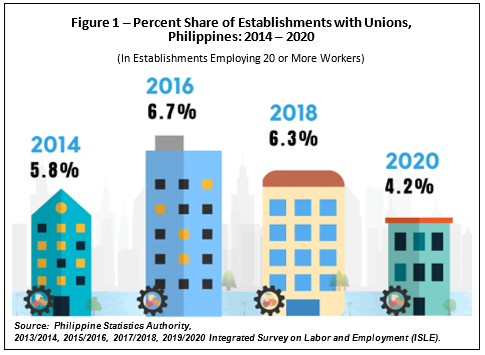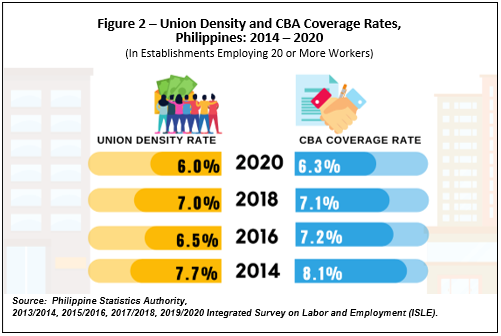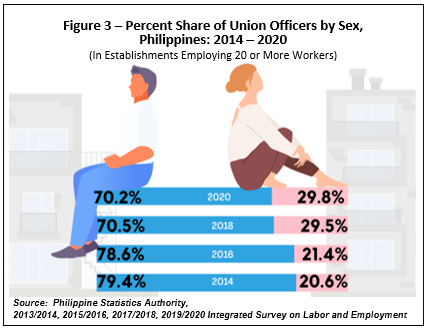EXTENT OF UNIONISM
- Results of the survey revealed that only 4.2 percent (1,464) of establishments with 20 or more workers (34,543) had registered unions in 2020, a decrease of -2.1 percentage points from the 6.3 percent share recorded in 2018 and the lowest since 2014.(Figure 1 and Table 1).

- By major industry group, electricity, gas, steam and air conditioning supply had the highest percentage of unionized establishments at 26.9 percent. This was followed by water supply; sewerage, waste management and remediation activities at 14.9 percent (49 out of 331) and manufacturing with 11.2 percent (664 out of 5,923). (Table 1)
- By employment size, large establishments employing 200 and more workers were more unionized with 12.6 percent compared to establishments with smaller employment sizes.
EXTENT OF COLLECTIVE BARGAINING
- Among the 1,464 unionized establishments in 2020, 99.1 percent or 1,451 had negotiated Collective Bargaining Agreements (CBAs). However, as proportion to total establishments, only 4.2 percent of establishments had CBAs. (Table 1)
- Large establishments with 200 and over were reported to have the highest negotiated CBAs at 12.6 percent. Around 8.2 of establishments with 100-199 workers had negotiated CBAs while it was only 2.0 percent for establishments with 20-99 workers.
UNION DENSITY RATE
- In 2020, union density rate or the proportion of union membership to total paid employees was at 6.0 percent, a decline of -1.0 percentage point from the 7.0 percent reported in 2018. This accounted to 316,458 unionized workers from the 5.29 million total paid employees. (Figure 2 and Table 2)

- Union density rates at more than 20 percent were reported in the following industries: electricity, gas, steam and air conditioning supply (24.9%); mining and quarrying (24.4%); water supply; sewerage, waste management and remediation activities (22.0%); and arts, entertainment and recreation (20.1%). (Table 2)
- Disaggregated by sex, male union density rate was recorded at 3.3 percent which means that 33 in every 1,000 paid employees were unionized male workers while female union density rate was at 2.7 percent. (Table 3)
CBA COVERAGE
- CBA coverage rate or the proportion of employees covered by CBAs to total paid employees was 6.3 percent or 333,776 of the 5.29 million total paid employees in 2020. This was lower by 0.8 percentage point from the 7.1 percent CBA coverage rate posted in 2018. (Figure 2 and Table 2).
- Across industries, about 27.2 percent of employees in mining and quarrying were covered by CBAs during the period. Likewise, high CBA coverage of employees in electricity, gas, steam and air conditioning supply and water supply, sewerage, waste management and remediation activities were reported at 26.2 percent and 24.3 percent, respectively. (Table 2)
- Disaggregated by sex, 3.4 percent or 34 in every 1,000 paid employees were male workers with CBA coverage while it was 2.9 percent for female workers. (Table 4)
- The percentage of employees covered by CBAs to total unionized workers was reported at 105.5 percent. This means that an employee may also receive the benefits stipulated in the CBA of the company despite not being a member of a union. (Table 5)
SHARE OF FEMALE UNION OFFICERS/PRESIDENTS
- Women accounted for 29.8 percent of the union officers while the proportion of men was higher at 70.2 percent in 2020. An upward trend can be observed from the 20.6 percent registered in 2014 to 2020 having an average of 3.1 percentage points increase for the survey periods covered. (Figure 3 and Table 6).
- The share of female union officers in establishments by major industry group showed that wholesale and retail trade; repair of motor vehicles and motorcycles had the highest at 60.3 percent. This is also the only industry wherein the share of female union officers is higher than of their male counterpart (39.7%). (Table 6)
- About 29.1 percent of the unionized establishments had a female president. Same as with the union officers, unionized establishments under wholesale and retail trade; repair of motor vehicles and motorcycles had the highest share of female presidents at 50.2 percent.

LABOR MANAGEMENT COOPERATION (LMC)
- In the absence of union, very few (7.1%) establishments in 2020 had created LMCs in which management and workers work together to achieve certain goals through consultations, discussions, negotiations, and information sharing. (Table 1)
- By major industry group, establishments in electricity, gas, steam and air conditioning supply had the highest share of establishments that created LMCs with 27.0 percent. Followed by financial and insurance activities (15.6%) and water supply; sewerage, waste management and remediation activities (12.8%).
- By employment size, LMCs were more prevalent in establishments employing 200 and more workers with 13.6 percent while lower employment size groups got lower prevalence with 9.7 percent and 5.4 percent for 100-199 workers and 20-99 workers, respectively.
DENNIS S. MAPA, Ph.D.
Undersecretary
National Statistician and Civil Registrar General
See more at the Integrated Survey on Labor and Employment Landing Page.
Survey Information:
This module of the 2019/2020 Integrated Survey on Labor and Employment (ISLE) focuses on unionism and collective bargaining in establishments employing 20 or more workers as of 30 June 2020. Specifically, this module inquires on the existence of registered unions; scope of bargaining unit whether composing of supervisors only, rank-and-file only, or rank-and-file including supervisors; number of union members by sex; and number of union officers by sex. For collective bargaining, queries involve existence and coverage of Collective Bargaining Agreements (CBAs) by scope of bargaining unit; and workers covered by CBAs classified by sex including non-union members paying agency fees. Information on the existence of an operating/active Labor Management Cooperation/Committee/Council (LMC) in the establishments is likewise included in this module.
Definition of Terms:
Establishment refers to an economic unit engaged in one or predominantly one kind of economic activity under a single ownership or control at a single fixed location, e.g., mine, factory, store, bank, etc.
Legal Organization (LO) is the legal form of the economic entity that owns the establishment. The types of LO are single proprietorship; partnership; government corporation; stock corporation; non-stock, non-profit corporation; cooperative; and others e.g., private associations, foundations, non-government organizations (NGOs), etc.
Union is defined as any registered group or association of employees that exists in whole or in part for the purpose of collective bargaining or dealing with employers concerning terms and conditions of employment. It also refers to a union whose registration is still in process as of reference date.
Collective Bargaining Agreement (CBA) refers to the negotiated contract between a legitimate labor organization and the employer concerning wages, hours of work, and all other terms and conditions of employment in a bargaining unit, including mandatory provisions for grievance and arbitration machinery.
Bargaining Unit is defined as a group of employees sharing mutual interest within a given employer, composed of all or less than all of the entire body of employees in the employer unit or any specific occupational or geographical grouping with such employer unit.
Labor Management Cooperation/Committee/Council (LMC) is defined as a state of relations where labor and management worked hand–in–hand to accomplish certain goals using mutually acceptable means.
